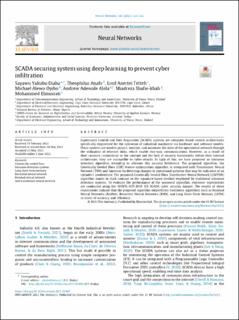SCADA securing system using deep learning to prevent cyber infiltration
Diaba, Sayawu Yakubu; Anafo, Theophilus; Tetteh, Lord Anertei; Oyibo, Michael Alewo; Alola, Andrew Adewale; Shafie-khah, Miadreza; Elmusrati, Mohammed
Peer reviewed, Journal article
Published version

View/
Date
2023Metadata
Show full item recordCollections
Abstract
Supervisory Control and Data Acquisition (SCADA) systems are computer-based control architectures specifically engineered for the operation of industrial machinery via hardware and software models.These systems are used to project, monitor, and automate the state of the operational network through the utilization of ethernet links, which enable two-way communications. However, as a result of their constant connectivity to the internet and the lack of security frameworks within their internal
architecture, they are susceptible to cyber-attacks. In light of this, we have proposed an intrusion detection algorithm, intending to alleviate this security bottleneck. The proposed algorithm, the Genetically Seeded Flora (GSF) feature optimization algorithm, is integrated with Transformer Neural Network (TNN) and functions by detecting changes in operational patterns that may be indicative of an intruder’s involvement. The proposed Genetically Seeded Flora Transformer Neural Network (GSFTNN)
algorithm stands in stark contrast to the signature-based method employed by traditional intrusion detection systems. To evaluate the performance of the proposed algorithm, extensive experiments are conducted using the WUSTL-IIOT-2018 ICS SCADA cyber security dataset. The results of these experiments indicate that the proposed algorithm outperforms traditional algorithms such as Residual Neural Networks (ResNet), Recurrent Neural Networks (RNN), and Long Short-Term Memory (LSTM) in terms of accuracy and efficiency.
